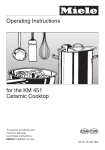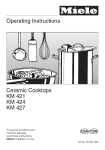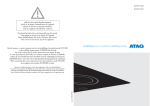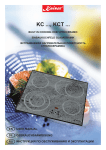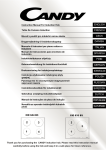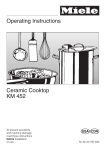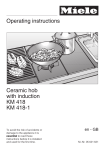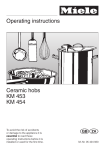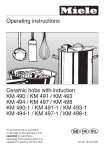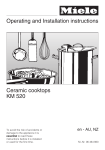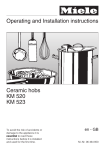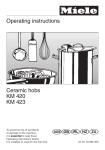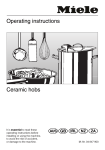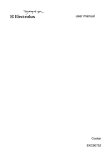Download Miele KM 460 Operating instructions
Transcript
Operating instructions Ceramic hobs KM 460 / KM 465 KM 461 / KM 464 / KM 466 KM 463 / KM 468 / KM 469 To avoid the risk of accidents or damage to the appliance it is essential to read these operating instructions before it is installed or used for the first time. GWHiOrZ M.-Nr. 05 397 124 2 Contents Guide to the appliance . . . . . . . . . . . . . . . . . . . . . . . . . . . . . . . . . . . . . . . . . . . . . 4 KM 460 / KM 465 . . . . . . . . . . . . . . . . . . . . . . . . . . . . . . . . . . . . . . . . . . . . . . . . . . . 4 KM 461 / KM 464 / KM 466 . . . . . . . . . . . . . . . . . . . . . . . . . . . . . . . . . . . . . . . . . . . 5 KM 463 / KM 468 / KM 469 . . . . . . . . . . . . . . . . . . . . . . . . . . . . . . . . . . . . . . . . . . . 6 Cooking zone controls and displays . . . . . . . . . . . . . . . . . . . . . . . . . . . . . . . . . . . . 7 Description of the cooking zones . . . . . . . . . . . . . . . . . . . . . . . . . . . . . . . . . . . . . . 8 Warning and Safety instructions . . . . . . . . . . . . . . . . . . . . . . . . . . . . . . . . . . . . . 9 Caring for the environment . . . . . . . . . . . . . . . . . . . . . . . . . . . . . . . . . . . . . . . . . 15 Before using for the first time . . . . . . . . . . . . . . . . . . . . . . . . . . . . . . . . . . . . . . . 16 General notes . . . . . . . . . . . . . . . . . . . . . . . . . . . . . . . . . . . . . . . . . . . . . . . . . . . . 16 Cleaning and heating up for the first time . . . . . . . . . . . . . . . . . . . . . . . . . . . . . . . 16 Use . . . . . . . . . . . . . . . . . . . . . . . . . . . . . . . . . . . . . . . . . . . . . . . . . . . . . . . . . . . . 17 Sensor switches . . . . . . . . . . . . . . . . . . . . . . . . . . . . . . . . . . . . . . . . . . . . . . . . . . . 17 Switching on . . . . . . . . . . . . . . . . . . . . . . . . . . . . . . . . . . . . . . . . . . . . . . . . . . . . . 17 Settings . . . . . . . . . . . . . . . . . . . . . . . . . . . . . . . . . . . . . . . . . . . . . . . . . . . . . . . . . 18 Auto heat-up . . . . . . . . . . . . . . . . . . . . . . . . . . . . . . . . . . . . . . . . . . . . . . . . . . . . . 19 Switching on an extended area . . . . . . . . . . . . . . . . . . . . . . . . . . . . . . . . . . . . . . . 20 Switching off and residual heat indicators. . . . . . . . . . . . . . . . . . . . . . . . . . . . . . . 21 Suitable pans . . . . . . . . . . . . . . . . . . . . . . . . . . . . . . . . . . . . . . . . . . . . . . . . . . . . . 22 Energy saving tips . . . . . . . . . . . . . . . . . . . . . . . . . . . . . . . . . . . . . . . . . . . . . . . . . 22 Safety features . . . . . . . . . . . . . . . . . . . . . . . . . . . . . . . . . . . . . . . . . . . . . . . . . . . 23 Safety lock . . . . . . . . . . . . . . . . . . . . . . . . . . . . . . . . . . . . . . . . . . . . . . . . . . . . . . . 23 Safety switch-off . . . . . . . . . . . . . . . . . . . . . . . . . . . . . . . . . . . . . . . . . . . . . . . . . . 24 Overheating protection . . . . . . . . . . . . . . . . . . . . . . . . . . . . . . . . . . . . . . . . . . . . . 26 Cleaning and care . . . . . . . . . . . . . . . . . . . . . . . . . . . . . . . . . . . . . . . . . . . . . . . . 27 Problem solving guide . . . . . . . . . . . . . . . . . . . . . . . . . . . . . . . . . . . . . . . . . . . . 29 Electrical connection . . . . . . . . . . . . . . . . . . . . . . . . . . . . . . . . . . . . . . . . . . . . . 31 Electrical connection AUS/NZ . . . . . . . . . . . . . . . . . . . . . . . . . . . . . . . . . . . . . . . . 33 Customer contact . . . . . . . . . . . . . . . . . . . . . . . . . . . . . . . . . . . . . . . . . . . . . . . . . 34 Data Plate . . . . . . . . . . . . . . . . . . . . . . . . . . . . . . . . . . . . . . . . . . . . . . . . . . . . . . . 34 3 Guide to the appliance KM 460 / KM 465 Ceramic hob abcd Single circle zone e Control area Control area f Cooking zone controls and displays g Hob ON / OFF h Safety lock Indicator light for: i Safety lock 4 Guide to the appliance KM 461 / KM 464 / KM 466 Ceramic hob a Double circle zone bcd Single circle zone e Control area Control area f Cooking zone controls and displays g Hob ON/OFF h Safety lock j Switching on the outer circle of the double circle zone Indicator lights for: i Safety lock k Switching on the outer circle of the double circle zone 5 Guide to the appliance KM 463 / KM 468 / KM 469 Ceramic hob a Double circle zone bd Single circle zone c Extended cooking zone (Multi-zone) e Control area Control area f Cooking zone controls and displays g Hob ON/OFF h Safety lock j Switching on the outer circle of the double circle zone or the extended cooking zone Indicator lights for: i Safety lock k Switching on the outer circle of the double circle zone or the extended cooking zone 6 Guide to the appliance Cooking zone controls and displays o 8. n m p l Cooking zone symbol m Displays: 0 = 1 to 9 = H = F = Cooking zone ready for use Power settings Residual heat Fault message (see on "Safety switch-off") n Indicator light for Auto heat-up o - and + sensor switches for selecting the power setting 7 Guide to the appliance Description of the cooking zones Cookingzone KM 460 / KM 465 KM 461 / KM 466 ø in cm Rating in watts ø in cm Rating in watts y 21.0 2000 14.5 / 21.0 1000 / 2000 w 14.5 1100 14.5 1100 x 18.0 1700 18.0 1700 z 14.5 1100 14.5 1100 Total: 230/5900 Cookingzone KM 463 / KM 468 KM 464 KM 469 ø in cm Rating in watts ø in cm Rating in watts ø in cm Rating in watts y 14.5 / 21.0 1000 / 2000 12.0 / 21.0 750 / 2200 12.0 / 21.0 750 / 2200 w 14.5 1100 14.5 1200 14.5 1200 x 17.0 17.0 x 26.5 1400 / 2200 18.0 1800 17.0 / 26.5 1500 / 2400 z 18.0 1700 14.5 1200 18.0 1800 Total: 230/7000 8 Total: 230/5900 Total: 230/6400 Total: 230/7600 Warning and Safety instructions Installation and connection The appliance must be installed and connected by a suitably qualified and competent person in strict accordance with national and local safety regulations. The manufacturer cannot be held liable for damage caused by incorrect installation or connection. The electrical safety of this appliance can only be guaranteed when continuity is complete between the appliance and an effective earthing system, which complies with local and national safety regulations. It is most important that this basic safety requirement is regularly tested, and if there is any doubt, the electrical wiring in the home should be inspected by a qualified electrician. The manufacturer cannot be held liable for the consequences of an inadequate earthing system (e.g. electric shock). This appliance must not be installed over a dishwasher, washing machine, tumble dryer, refrigerator, freezer or fridge-freezer. The high temperatures radiated by it could damage the appliance below. This equipment may only be used in mobile installations such as ships, caravans, aircraft etc. if a risk assessment of the installation has been carried out by a suitably qualified engineer. On hobs with bevelled glass edges a small gap may be visible between the hob and the worktop during the first few days after installation. This gap will reduce with time as the appliance is used and will not affect the electrical safety of your appliance. Do not connect the appliance to the mains electricity supply by an extension lead. Extension leads do not guarantee the required safety of the appliance (e.g. danger of overheating). 9 Warning and Safety instructions Correct usage To avoid the risk of accidents and damage to the appliance you should read these operating instructions carefully before using it for the first time. They contain important notes on the safety, operation and care of the appliance. For safety reasons this appliance must only be operated after it has been built in. This is necessary to ensure that all electrical components are shielded. This appliance is intended for domestic use only and is not to be used for commercial purposes. Only use the appliance to prepare food in the home. Any other usage is at the owner's risk and could be dangerous. The manufacturer cannot be held liable for damage caused by incorrect or improper use of the appliance. 10 Do not use the appliance to heat up the room. Due to the high temperatures radiated, objects near the appliance could catch fire. The life of the appliance could also be reduced. Prolonged, intensive use of the appliance can cause the control area to heat up. This is quite normal and does not indicate a fault. Warning and Safety instructions Safety with children The appliance is only intended for use by adults who have read these operating instructions. This appliance is not a toy! To avoid the risk of injury keep children well away and do not let them play with it or use the controls. They will not understand the potential dangers posed by it. They should be supervised whenever you are working in the kitchen. Older children may use the appliance only when its operation has been clearly explained to them, and they are able to use it safely, recognising the dangers of misuse. Supervise its use by the elderly or infirm. Keep all pans out of reach of children. Turn pan handles inwards away from the edge of the hob. Danger of burning or scalding. Special hob guards are available from good retail outlets. Packaging (e.g. cling film, polystyrene) and plastic wrappings must be kept out of the reach of babies and young children. Danger of suffocation. Dispose of all packaging safely as soon as possible. Old appliances must be disconnected from the power supply, the plug rendered useless and the cable cut off directly behind the appliance to ensure it presents no danger to children while being stored for disposal. Use the safety lock to prevent children operating the appliance or altering the settings. The appliance gets hot when in use and remains hot for quite a while after being switched off. To safeguard against burning, keep children well away from the appliance at all times. Do not store anything which might arouse a child's interest in storage areas above or next to the appliance. Otherwise they could be tempted into climbing onto the appliance with the risk of burning themselves. 11 Warning and Safety instructions Protecting the appliance from damage Do not drop anything on the ceramic surface. Even a light object could cause damage in certain circumstances. Do not use pots or pans on the ceramic hob with bases with pronounced edges or ridges. These could scratch or scour the hob surface permanently. Grains of salt and sand can also scratch. Do not allow either solid or liquid sugar, or pieces of plastic or aluminium foil to get on ceramic cooking zones when they are hot. If this should occur, switch off the hob and carefully scrape off all the sugar, plastic or aluminium remains from the hob while it is still hot using a shielded scraper blade. Take care not to burn yourself. If these residues are allowed to cool before the hob surface has been cleaned, the ceramic surface will be susceptible to pitting or even cracking. Clean the appliance once it has cooled down. To prevent the risk of spillages etc. burning on, remove any soiling as quickly as possible and ensure that pan bases are clean, dry and free of grease. 12 Do not use a steam cleaner to clean this appliance. The steam could reach electrical components and cause a short circuit. Pressurised steam could also cause permanent damage to the surface and to other components, for which the manufacturer cannot accept liability. Unless the pan manufacturer states that you can do so, do not use pans with very thin bases on this hob and never heat up empty pans as they could get damaged. This could also damage the appliance. Never place hot pans near the control area. This could damage the electronic unit underneath. In countries where there are areas which may be subject to infestation by cockroaches or other vermin, pay particular attention to keeping the appliance and its surroundings in a clean condition at all times. Any damage which may be caused by cockroaches or other vermin will not be covered by the appliance guarantee. Warning and Safety instructions Protection from burning and scalding The surface of the appliance is hot when in use, and remains hot for quite a while after being switched off. There is a danger of burning until the residual heat indicators go out. For added protection it is advisable to use heat-resistant pot holders or gloves when using the appliance. Do not let them get damp or wet, as this causes heat to transfer through the material more quickly with the risk of scalding or burning yourself. Do not heat up unopened tins of food on the hob as pressure will build up in the tin and it can explode. This could result in injury and scalding or damage. Do not cover the appliance, e.g. with a cloth, kitchen foil, etc. This could be a fire hazard if the appliance is switched on by mistake. Never leave the appliance unattended when cooking with oil or fat as these are fire hazards if overheated. Very hot oil can catch fire and could even set a cooker hood above on fire. Always heat fat slowly, watching as it heats. If, despite this, oil or fat does catch fire, do not attempt to put out the flames with water. Use a suitable fire blanket, saucepan lid, damp towel or similar to smother the flames. Do not flambé under a cooker hood. The flames could set the cooker hood on fire. Do not use the hob as a resting place for anything else. The article could melt or catch fire if residual heat is still present or if the appliance is switched on by mistake. 13 Warning and Safety instructions Appliance faults Further safety notes In the event of damage or a defect, switch off the appliance immediately. Disconnect completely from the electricity supply. If the appliance has not yet been fully installed, the electricity cable must be disconnected from the supply point. If connected via a plug and socket, switch off at the socket and withdraw the plug. Contact the Service Department. Do not reconnect the appliance to the mains electricity supply until after it has been repaired. When using an electric socket near the appliance, care should be taken that the cable of the electrical appliance does not come into contact with the hot appliance. The insulation on the cable could become damaged, giving rise to an electric shock hazard. If there is any damage to the ceramic surface the appliance must be disconnected from the mains electricity supply immediately and not used until it has been repaired. Danger of electric shock. Repairs must only be carried out by a suitably qualified and competent person. Repairs and other work by unqualified persons could be very dangerous and could damage the appliance. The manufacturer cannot be held liable for unauthorised work. Never open the housing of the appliance. While the appliance is under guarantee, repairs should only be undertaken by a service technician authorised by the manufacturer. Otherwise the guarantee is invalidated. Always ensure that food is sufficiently cooked or reheated. Many factors will affect the overall cooking time, including the size and amount of food and its temperature. Some foods may contain micro-organisms which are only destroyed by thorough cooking; therefore when cooking or reheating foods such as poultry, it is particularly important that the food is completely cooked through. If in doubt, select a longer cooking or reheating time. Do not use plastic or aluminium foil containers. These melt at high temperatures and could damage the ceramic surface. Fire hazard. If a domestic animal gets onto the hob, a sensor switch could be touched and a cooking zone switched on. Keep pets away from the hob at all times. Spray canisters, aerosols and other inflammable substances must not be stored in a drawer under the hob. Cutlery inserts must be heat-resistant. The manufacturer cannot be held liable for damage caused by non-compliance with these Warning and Safety instructions. 14 Caring for the environment Disposal of packing material The transport and protective packing has been selected from materials which are environmentally friendly for disposal and can normally be recycled. Packaging (e.g. cling film, polystyrene) and plastic wrappings must be kept out of the reach of babies and young children. Danger of suffocation. Dispose of or recycle all packaging materials as soon as possible. Disposal of your old appliance Electrical and electronic appliances often contain materials which, if handled or disposed of incorrectly, could be potentially hazardous to human health and to the environment. They are, however, essential for the correct functioning of your appliance. Please do not therefore dispose of your old appliance with your household waste. Please dispose of it at your local community waste collection / recycling centre and ensure that it presents no danger to children while being stored for disposal. It should be unplugged or disconnected from the mains electricity supply by a competent person. The plug must be rendered useless and the cable cut off directly behind it to prevent misuse. 15 Before using for the first time General notes A data plate for your appliance is supplied with this documentation. It should be stuck into the space provided at the end of the instruction book. Keep these instructions in a safe place for reference and pass them on to any future user. Cleaning and heating up for the first time Before using for the first time, clean the appliance with a damp cloth only and then wipe dry. Do not use washing up liquid on the ceramic surface as it can leave a blue sheen which may be difficult to remove. Metal components have a protective coating which may give off a slight smell when the hob is heated up for the first time. The smell and any vapours will dissipate after a short time and do not indicate a faulty connection or appliance. 16 Use Sensor switches Switching on This hob is equipped with electronic sensor switches which react to finger contact. To operate a cooking zone touch the relevant sensor switch. Each time you touch a sensor switch an audible tone sounds. The hob must be switched on before any of the zones can be used. Make sure that you only touch the sensor you require (except when switching off a cooking zone), and that you touch the centre of the sensor. Take care to keep the control area clean. Do not place anything on the control area. The sensors may fail to react or they could mistake the article or any dirt for a fingertip contact, thereby activating a function or even causing the hob to switch off automatically (see Safety switch-off.) Never place hot pans on the sensors. The electronic unit underneath could get damaged. To switch the hob on: ^ Touch the ON/OFF sensor s. A 0 appears in the display for each of the zones. If no further entry is made, the hob will switch itself off after a few seconds for safety reasons. To switch a cooking zone on: ^ Select a power setting between 1 and 9 by touching the - or + sensor. To select cooking with Auto heat-up, press the - sensor first, see "Auto heat-up". To select cooking without Auto heat-up press the + sensor first. If you wish to switch on another cooking zone, and the 0 for that zone has already gone out, simply press the - or + briefly. The 0 will appear and you can select a power setting (with or without Auto heat-up). 17 Use Settings Cooking process Settings Melting butter, chocolate etc. Dissolving gelatine Preparing yoghurt 1-2 Thickening sauces containing egg yolk and butter Warming small quantities of food/liquid Keeping warm food which sticks easily Cooking rice 1-3 Warming liquid and semi-solid foods Thickening sauces, e.g. Hollandaise Making porridge Preparing omelettes, lightly fried eggs Steaming fruit 2-4 Defrosting deep frozen food Steaming vegetables, fish Cooking dumplings, potatoes, pulses Cooking broths, pulse soups 3-5 Bringing to the boil and continued cooking of large quantities of food 5 Gentle braising (without overheating the fat) of meat, fish, vegetables, fried eggs etc. 6-7 Frying pancakes etc. 7-8 Boiling large quantities of water Bringing to the boil 8-9 These settings, which envisage approx. 4 helpings, should only be taken as a guide. With deep pans, large quantities or without the lid on, a higher setting is needed. With smaller quantities, select a lower setting. 18 Use Auto heat-up How to activate Auto heat-up: When Auto heat up has been activated, the cooking zone switches on automatically at the highest setting and then switches to the continued cooking setting which you have previously selected. The "heat up" time depends on which continued cooking setting has been chosen (see chart). ^ While a 0 is flashing in the cooking zone display, touch the - sensor until the required continued cooking setting appears, e.g. 6. We recommend that you use a high continued cooking setting for frying food. This means that for frying only a relatively short heat-up time is needed to heat up the pan initially. Continued cooking setting Heat-up time in minutes and seconds (approx.) 1 1 : 20 2 2 : 45 3 4 : 05 4 5 : 30 5 6 : 50 6 1 : 20 7 2 : 45 8 2 : 45 9 - 6. During the heat-up time a dot will light up to the right of the continued cooking setting, and go out at the end of it. At any point during the heat-up time you can use - or + to increase or lower the continued cooking setting. The heat-up time will alter accordingly. 19 Use Switching on an extended area Depending on the model of hob, the outer circle of the double circle zone or the extended cooking zone can be switched on to provide an extended cooking area when cooking with larger pans. ^ Switch the zone on by pressing the or + sensor and select a power setting. ^ Then press the sensor for the outer circle of the double circle zone or the extended cooking zone n. If a 0 is showing in the cooking zone display, you can press the n sensor first and then choose a power setting. 20 An indicator light will come on to show that the outer circle / extended cooking zone is switched on. 5 n To switch the outer circle or extended cooking zone off, press the n sensor again or set the display for the zone back to 0. Use Switching off and residual heat indicators To switch off a cooking zone: ^ Press the - and + sensors for the zone you want to switch off at the same time. A 0 will light up in the display for that zone for a few seconds. If the cooking zone is still hot, residual heat will then be indicated in the display. The residual heat indicators will not go out until the cooking zone is safe to touch. If residual heat indicators are on, do not touch the cooking zones or place any heat sensitive object on them. Danger of burning and fire. N.B. If there is a power cut the indicator light will go out, even if the cooking zone is still hot. h To switch off the hob: ^ Press the ON / OFF sensor s. This switches off all cooking zones. If any cooking zone is still hot, then residual heat will be indicated in its display. 21 Use Suitable pans Energy saving tips – For optimum energy consumption during cooking, only pans with flat or very slightly concave bases should be used. When the pan is hot, the base should rest evenly on the hob. Uneven bases will lengthen cooking time. Check for suitability when purchasing new pans. – Use a pan lid whenever possible to minimise heat loss. uncovered cold hot – Check that the diameter of the pan base is wide enough for the cooking zone so that heat is not lost unnecessarily. Please note that the maximum diameter quoted by manufacturers often refers to the diameter of the top rim of the pan. The diameter of the base (generally smaller) is more important. too small 22 suitable covered – When cooking for a long time, switch the cooking zone off about 5 to 10 minutes before the end of the cooking time. In this way use is made of the residual heat. Safety features Safety lock To activate the safety lock: Keep children away from the hob for their own safety. In addition, your appliance is equipped with a safety lock to prevent the hob and the cooking zones being switched on or any settings being altered. ^ Press the safety lock sensor a until the relevant indicator light comes on. The safety lock can be activated when the hob is switched off as well as when it is in use. The indicator light will go out after a short while. The light will come on again to show that the safety lock has been activated, if – you press the safety lock sensor a. If the safety lock is activated when the hob is switched off, then the hob cannot be switched on. – you try to change a setting. If the safety lock is activated when the hob is in use, please note the following: ^ Press the safety lock sensor a until the indicator light goes out. – the cooking zone power settings cannot be changed. To de-activate the safety lock: Please note that the safety lock will deactivate if there is a power cut. – the cooking zones and hob can still be switched off but once switched off cannot be switched on again. 23 Safety features Safety switch-off Power setting Maximum length of operating time in hours Your hob is fitted with a safety switch-off feature in case you forget to switch it off yourself. 1 10 2 5 If one of the cooking zones is heated for an unusually long period of time (see chart), and the power settings are not altered, the hob will switch itself off automatically and the appropriate residual heat indicator will appear. 3 5 4 4 5 3 6 2 7 2 8 2 9 1 Safety switch-off with an over-long cooking time ^ To use the cooking zone again, switch the hob back on again in the usual way. 24 Safety features Safety switch-off if the sensors are covered ^ Clean the control area or remove the obstruction. Your hob will switch itself off automatically if one or several of the sensors remain covered for more than about 10 seconds, for example by finger contact, food boiling over, or by an object such as an oven glove or a tea towel. At the same time as the hob switches itself off an audible tone will sound every 30 seconds (for a maximum of 10 minutes) and an F will flash in the display of the sensor which has been covered: This will turn off the tone and the F will go out. ^ Switch the hob back on again with the ON / OFF sensor s. The cooking zones can now be used again. 25 Safety features Overheating protection Overheating can be caused by: Each cooking zone is equipped with overheating protection. An internal temperature limiter switches off the heating elements in the cooking zone before the ceramic surface overheats. – switching on a cooking zone without a pan on it. Once the ceramic has cooled down to a safe level the heating will automatically switch back on again. – heating up an empty pan. – the base of a pan not sitting evenly on the cooking zone. – the pan not conducting the heat properly. You can tell that the overheating protection has activated because the heating switches on and off even when the highest setting is selected. 26 Cleaning and care Do not use a steam cleaner to clean this appliance. The steam could reach electrical components and cause a short circuit. Pressurised steam could also cause permanent damage to the surface and to components, for which the manufacturer cannot accept liability. Do not use any sharp objects which could damage the seal between the ceramic surface and the surrounding frame and between the frame and the worktop. Never use cleaners containing sand, soda, alkalis, acids or chlorides, oven sprays, dishwasher detergents, nor steel wool, abrasive cleaning agents, hard brushes, scouring pads and cloths. You should also avoid using sponges etc. which have previously been used with abrasive cleaning agents, as this will damage the surface. Do not use washing up liquid to clean the ceramic surface as it can leave a blue sheen which may be difficult to remove. E-Cloth A microfibre "E-Cloth" is available from the Miele UK Spare Parts Department which is suitable for cleaning surfaces such as stainless steel, glass, plastic and chrome without the use of chemicals. Clean the appliance regularly, preferably after each use. Allow the hob to cool down before cleaning. To prevent the risk of spillages burning on, remove any soiling as soon as possible, and ensure that pan bases are clean, dry and free of grease. Most soiling can be wiped off using a damp cloth. Stubborn soiling may need to be removed with a shielded scraper blade. After cleaning, dry thoroughly with a soft cloth to prevent a build-up of limescale deposits To remove any limescale deposits, caused for example by water boiling oven as well as metallic marks e.g. from saucepan bases, the ceramic surface can be cleaned using a proprietary cleaning agent for ceramic surfaces. Follow the manufacturer's instructions on the packaging and apply using a soft cloth or kitchen paper towel. Finally, wipe the hob surface with a damp cloth and then dry it with a clean soft cloth. Ensure that every trace of cleaner has been removed from the surface. Any remaining trace could have a corrosive effect on the hob when it is next heated up. Note that some cleaning agents contain a protective additive designed to prevent water marks and smears adhering to the surface. 27 Cleaning and care Should any sugar, plastic or aluminium foil spill or fall on to a hot cooking zone while it is in use, first switch off the appliance. Then, immediately, while they are still hot, scrape off all remains of these materials using a shielded scraper blade. Take care not to burn yourself. Allow the hob to cool down and then clean with a suitable proprietary ceramic cleaner. Appliances with aluminium frames (see data plate) are prone to scratching, alkali and acid damage. Take great care when cleaning the aluminium frame. Do not use cleaning agents for stainless steel or descaling agents on aluminium surfaces. Soiling should be wiped off as soon as possible after using the appliance. If the soiling is left for a long time it can have a damaging effect on the aluminium surfaces. Intensive cleaning with proprietory ceramic cleaners can cause the frame to take on a shiny appearance. 28 Problem solving guide Installation work and repairs to electrical components of this appliance must only be carried out by a suitably qualified and competent person in accordance with local and national safety regulations. Repairs and other work by unqualified persons could be dangerous. The manufacturer cannot be held liable for unauthorised work. What to do if ... ... the hob or cooking zones cannot be switched on ... the hob switches off while it is in use and a residual heat indicator H or a flashing F appears in the display for at least one of the cooking zones and at the same time an audible tone sounds One of the cooking zones has probably been on for too long, or one of the sensors may have been covered over (see "Safety switch-off"). ... the heating switches on and off at the highest setting on one of the cooking zones The overheating protection mechanism has been triggered (see "Overheating protection"). Check whether – the safety lock is activated. If necessary, deactivate it (see "Safety lock"). – the mains fuse has blown. If none of the above is the case, then disconnect the appliance from the electricity supply for approx. 1 minute. To do this: – switch off at the isolator, or – withdraw the mains fuse. Reconnect to the mains supply and switch the appliance on. If it still does not heat up then contact a qualified electrician or the Miele Service Department. ... the food in the pan hardly heats up or does not heat up at all when the Auto heat-up function is switched on This could be because: – the pan is not conducting heat properly. – there is too much food in the pan. Select a higher continued cooking setting next time or start cooking at the highest setting and then turn down to a lower setting manually later on. 29 Problem solving guide ... the sensors are over sensitive or do not react at all. The sensitivity level of the sensors has changed. It can be corrected as follows: – Make sure that there is no direct light (from the sun or from an artificial source) falling onto the hob and that the surrounding area is not too dark. – Make sure that there is nothing covering the sensors or the hob. Take any pans off the hob and wipe away any food deposits. – Interrupt the power supply to the hob for approx. 1 minute. 30 Reconnect the hob to the electricity supply. The electronic unit will reset the sensitivity levels of the sensors. If this action does not solve the problem please call the Miele Service department. Electrical connection All electrical work should be carried out by a suitably qualified and competent person in strict accordance with national and local safety regulations. Installation, repairs and other work by unqualified persons could be dangerous. The manufacturer cannot be held liable for unauthorised work. Ensure power is not supplied to the appliance until after installation or repair work has been carried out The appliance must only be operated when built-in. This is to ensure that all electrical parts are shielded. Live parts must not be exposed. Do not connect the appliance to the mains electricity supply by an extension lead. These do not guarantee the required safety of the appliance. Connection should be made via a suitable isolator which complies with national and local safety regulations, and the On/Off switch should be easily accessible after the appliance has been built in. If the switch is not accessible after installation (depending on country) an additional means of disconnection must be provided for all poles. For extra safety it is advisable to install a residual current device (RCD), with a trip current of 30 mA. When switched off there must be an all-pole contact gap of at least 3 mm in the isolator switch (including switch, fuses and relays). Important U.K. The appliance is supplied for connection to a 230-240 V, 50 Hz supply with a 3-core cable. The wires in the mains lead are coloured in accordance with the following code: Green/yellow = earth The voltage and connected load are given on the data plate. Ensure that these match the household mains supply. Blue = neutral Brown = live 31 Electrical connection WARNING THIS APPLIANCE MUST BE EARTHED The electrical safety of this appliance can only be guaranteed when continuity is complete between the appliance and an effective earthing system, which complies with local and national regulations. It is most important that this basic safety requirement is regularly tested and if there is any doubt, the electrical wiring in the home should be inspected by a qualified electrician. The manufacturer cannot be held liable for the consequences of an inadequate earthing system such as an electric shock. The manufacturer cannot be held liable for damage which is the direct or indirect result of incorrect installation or connection. 32 Electrical connection Electrical connection AUS/NZ All electrical work should be carried out by a competent person, in strict accordance with national and local safety regulations. The voltage and rated load are given on the data plate. Please ensure that these match the household mains supply. Ensure power is not restored to the appliance while installation work is being carried out. Test marks Electrical safety, C-Tick Mark Electrically suppressed according to AS/NZS 1044 After the appliance has been built in, a check must be made that all electrical parts are shielded. Connection for each appliance should be made via a suitable isolator, which complies with national and local safety regulations and which is accessible after the appliance has been built in. For extra safety it is advisable to install a residual current device (RCD), with a trip current of 30 mA. Important The wires in the mains lead are coloured in accordance with the following code: Green/yellow = earth Blue = neutral Brown = live. WARNING: THIS APPLIANCE MUST BE EARTHED 33 Electrical connection Customer contact The address of the nearest Service Department is given on the back page. The voltage and rated load are given on the data plate. Please quote these data, together with the model description and serial number when contacting the Service Department. Please note that telephone calls may be monitored and recorded to improve our service. Data Plate Space in which to stick the extra data plate supplied with the appliance. Ensure that the model number is the same as the one on the front of these operating instructions. 34 35 Alteration rights reserved / 4004 M.-Nr. 05 397 124 / 01 en - –




































